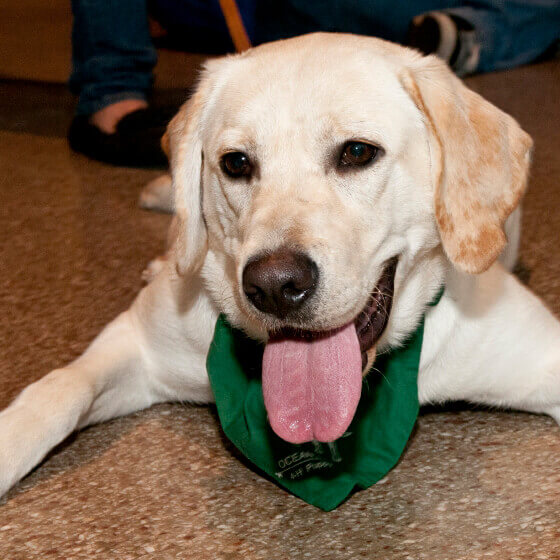Retrievers Shown as Most Playful of Breeds Tested
WEST LONG BRANCH, N.J. — Monmouth University animal behaviorist Lindsay R. Mehrkam, Ph.D., BCBC-D, is the lead author of the first study to demonstrate a relationship between specific breed type and form of play behavior in domestic dogs. The study, “The influence of breed and environmental factors on social and solitary play in dogs (Canis lupus familiaris),” appeared earlier this month in the journal Learning & Behavior.
According to Mehrkam, the study team was interested in determining what contexts may motivate dogs to play with one another and if those contexts would affect the form in which dogs play: playing by themselves, playing with other dogs or playing with a toy. Additionally, the researchers were very interested in determining if breed was a determining factor in influencing how often dogs engage in certain types of play.
While play traditionally has been harder to define than other forms of behavior, this study suggests that, like other more well-studied behaviors, play is a product of genetic breed-typical predispositions, environment and experience with incentives that the animal has learned over its lifetime.
Mehrkam, an assistant professor of psychology, tested play behavior in retrievers (golden retrievers, Labrador retrievers), herding dogs (border collies, Australian shepherds, German shepherds) and livestock guarding dogs (Great Pyrenees, Anatolian shepherds).
Different breeds of dogs have different predatory motor patterns, which are based on the intact predatory sequence of wolves. “A wolf will eye their prey, stalk their prey, chase their prey, bite their prey and dissect their prey,” explained Mehrkam, “and that’s all part of the predatory motor pattern.”
Mehrkam said that the three breeds of dogs were selected from a biological or evolutionary perspective, as these breed groups were the most distinctive.
The chosen groups will vary reliably in what portions of the predatory sequence they will perform. She explained that retrievers should have a strong grab, but should not dissect what they are sent to get. Herders should not have a grab at all, but have a strong eye, strong chase and strong stalk. Livestock guarding dogs have been bred to eliminate the predatory motor pattern because they are living among the livestock they are guarding.
The study found that retrievers were significantly more likely to engage in solitary play than were livestock guarding dogs and a trend was found for more play in retrievers compared to herders; however, levels of social play—defined as play between dogs —did not differ significantly from breed to breed.
“Overall, retrievers did play more than any other breed type,” she said. “They were reliably the most playful, which probably won’t be surprising to anyone who owns golden retrievers or Labradors. And while they did engage in the highest levels of play, they didn’t play with a toy more often than the other breed types did.”
While the study did find that, by far, the toy was the best predictor of solitary play, the best predictor of play between dogs was the presence of a human.
“Interestingly, the retrievers and the herders were more likely to play with each other when it was owner attention and livestock guarding dogs were more likely to play with each other when it was attention from a less familiar person, which was kind of interesting given what they’re bred to do,” she said.
“This was the first study that’s shown experimentally that owner attention or human attention can reliably facilitate play in dogs; facilitate play in a different species. That’s really not been shown experimentally before. There have been some observational studies where people have reported that when they’re around they’ll see their dogs playing more but not [in a controlled study].”
Play in animals is a topic that Mehrkam believes many of her fellow animal behaviorists are not quick to study because, she says, “play can be difficult to operationally define.”
While play in humans is generally seen as an activity that brings happiness or joy, Mehrkam said that certain studies on the neurobiology of play in basic lab animals show that during play more dopamine is activated but that, “we don’t yet know what motivates an animal to play.”

